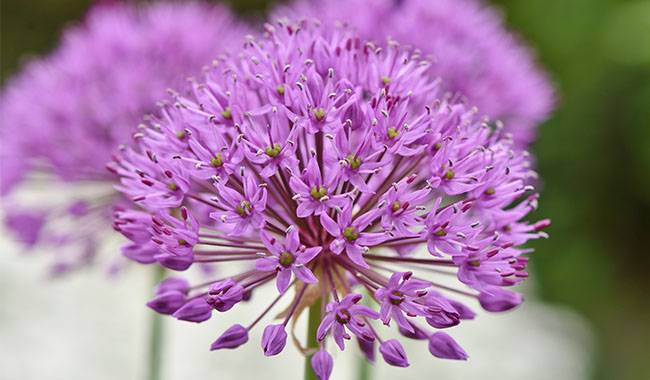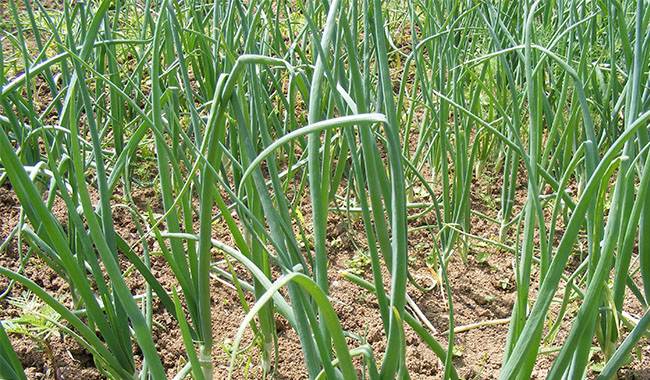
The alliums (onions genus) are very widespread and diverse. Even the well-known garlic is technically one of the species of onions. Globally, alliums are further divided into vegetable and ornamental categories.
But some representatives of onions are universal – they are not only on the table but also decorate the neighborhood, originally complementing the ornamental perennials. This includes, in particular, onions.
So far, it is not often seen in the garden, but this crop deserves more attention. What makes them so good?
ALLIUM – A PORTRAIT OF THE PLANT
Allium is sometimes referred to as dip onion, Siberian onion, and glandular onion. It is named mainly because of the rich mucilage it produces when the leaves are harvested.
This onion is characterized by its small bulb 0.6-0.8inch (1.5-2 cm) attached to the rhizome. Because of its small size, it may not even be easy to see, and the plant appears to be rhizomatous. Allium bulbs are very edible, but mainly these allium bulbs are interested in feathering.
Because of these characteristics of the root system, Allium is easier to care for and maintains a stable, aesthetically pleasing appearance. Its bulbs do not require regular digging and drying, tolerate temperature conditions in the middle zone well, and do not freeze in winter. In addition, it can grow in one place for a long time, but it is better to divide it once every five years.
Allium’s leaves are very ornamental, do not turn yellow, and do not wilt after flowering. The leaves are collected in bunches of 8-9 leaves, are flat with a greenish-blue patina, and have a slight spiral curve with very blunt tips.
Some varieties of Allium have more curled leaves that become the main decoration of the plant throughout the season, but cultivars with very little curl are no less impressive in the flower garden.
Onions do not exceed 12inch (30cm) in height before flowering, and together with the pedicel, the plant reaches a height of 23-31inch (60-80cm). This type of onion forms wide clumps, but it does not become invasive or disturb other plants.
Most ornamental onions flower in the first half of the summer, and by mid-season, they remind themselves only in the form of dried flowers. allium, due to its biology, has just come to replace the first alliums, flowering in mid-late July.
It has small flower heads: 1.2-1.6inch (3-4 cm) in diameter, but they are very numerous and have a long flowering period. The flowers are mostly pale lilac in color, but pure white, pink, and more brightly colored varieties are also available.
The slender Allium remains attractive after blooming through the winter due to the graphic tan spherical heads that dance in the autumn breeze. During flowering, the nectar-filled inflorescence acts like a magnet for butterflies.
USEFUL PROPERTIES AND CULINARY USES
As soon as the snow melts, the vitamin green leaves of Allium become available. Planting this unique plant once in your garden is enough to enjoy delicious and healthy greens every spring.
Thanks to the special chemical composition of Allium feathers, it is not bitter or astringent and has a pleasant garlic flavor. We prefer to add these onions to fresh salads and soups. But it has a much wider culinary use. It can be added to stews, pies, meat dishes, omelets, pickled, procured, or dried for winter.
Because of its rich composition, it is a veritable treasure trove of vitamins and can rightly be called a green healer. Allium is recommended for people with thyroid disorders, reproductive problems, colds, gastrointestinal disorders, vitamin deficiencies, anemia, cancer prevention, and external – wound healing. In moderation, it is even allowed for nursing mothers and children over 1 year old.
Outwardly, in the form of a mask to strengthen the hair and improve the skin. Such a wide range of applications ensures the presence of vitamins (A, C, group B, PP, K), zinc, potassium, calcium, manganese, flavonoids, phytonutrients, and various salts.
ALLIUM IN A FLOWER BED

Despite its broad utility, Allium is, for me, first and foremost a valuable ornamental perennial. Its delicate and refined texture sets this onion apart from other garden plants with less interesting foliage.
In my garden, it grows on a natural-style mixed board. This ornamental light foliage provides a successful backdrop for lilac onion heads. This combination looks very stylish and sophisticated. And when Allium is not in bloom, it creates a decorative blue halo under a crown of willows.
Probably there are no such perennial or decorative shrubs with which sluice onions cannot form a successful combination. But combinations with yarrow, allium, sage, Blackroot, and grasses or conifers would make the greatest impression.
Thanks to the presence of these Allium in our gardens, we can even see winged beauties of rare species in our flower beds. Last year, for example, we had a visit from a very showy Scarce swallowtail butterfly, which is uncommon in our area.
In natural flower beds where structural play is very important, this onion is simply irreplaceable: the attractive fluffy inflorescence balls and linear foliage never lose their shape. In addition, it can be used for floral compositions – Allium lasts a long time in cuttings and when dried is a precious dried flower.
PLANTING AND CARE
This type of Allium is a rather low-profile plant, which can be cut in late autumn after flowering, or you can postpone this procedure until spring.
Some gardeners recommend cutting the above-ground parts of the onion completely before the cold damage, which, in their opinion, helps to improve the resistance of the onion to frost. However, this culture is quite a winter hardy without it: up to -40°F (-40°C), and I only like to cut off the wilted flower stems in spring.
Allium has an average growth rate and can grow in one place without causing any problems to the gardener for about 5 years under favorable conditions. After this time, it is best to divide Allium into individual rosettes.
The best time to divide is early spring, when the greenery is already showing, or late fall. The rhizome pieces can be cut off with a spade or separated by hand. Plant young rosettes in new locations, 12-16inch (20-30cm) apart from each other.
This plant is best grown in full sun or in a light semi-shade. Sticky Bark Allium prefers dry or moderately moist soil with good drainage, as it often dies from waterlogged roots (meltwater, or prolonged waterlogging after rain). However, it is still recommended to water the onion during dry periods.
If you grow Allium as a vegetable plant, water it regularly, otherwise it will cause the leaves to be too tough.
The crop has no special requirements for the type of soil, but it is too acidic to like it. Allium is very tolerant of polluted city air and will bloom profusely and grow well in cities.
PROPAGATION OF ALLIUM
The fastest and most reliable way to have a large onion patch is to buy seedlings. However, onions can also be raised from seed by sowing seedlings indoors in March. However, you will not be able to harvest them until the third year.
Sometimes Allium is used as a potted plant in order to have fresh herbs on hand almost all year round. For this purpose, in late autumn, before the onset of frost, dig up small divisions, plant them in pots and send them to the basement. This measure is necessary to provide a short resting period for the onions (at least a month).
After that, place the pots with the plants in a bright window. As soon as the onions start to grow, they can be used as a fresh vitamin condiment.



